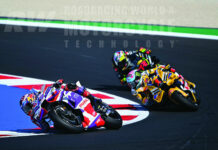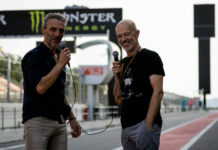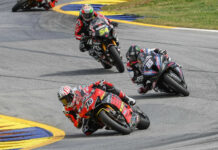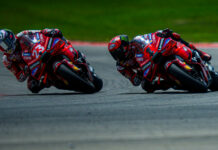From two press releases:
SUZUKI IN TOP FIVE AT CRUCIAL TESTS
April 2nd, 2002.
TEAM Telefónica MoviStar Suzuki rider Kenny Roberts Jr. posted fifth-fastest times at the Japanese GP circuit at the final pre-season tests before the first ever race of the new MotoGP era. The 2000 World Champion put the Suzuki well up among the new-generation four-stroke machines, with his team-mates close behind.
Roberts circulated the revised Suzuka circuit in 2:05.807, within 1.5-seconds of session leader Valentino Rossi. Kenny’s Suzuki was the next-best four-stroke, after Rossi and his Honda team-mate Tohru Ukawa, who both had extra sessions at this difficult circuit the previous weeks.
Full-time team-mate Sete Gibernau was within two tenths of Roberts, placed ninth fastest, sandwiched by factory testers Akira Ryo (eighth) and Yukio Kagayama.
This was the team’s first outing since the last European tests at Catalunya in Spain, and revisions to both engine and chassis performance had the riders complimenting the factory on the rapid progress with the all-new V4 machine – the GSV-R, which was released a full year earlier than planned to take part in the new era of GP racing.
KENNY ROBERTS – BETTER EVERY TIME.
“The bike has been constantly improving in all the different aspects. Some things were in the pipeline already, others are in response to what we found in our tests. The factory is trying to fix them all at the same time. We’re still getting a handle on how it all works – the motor, the chassis and the tyres. We’ve gotten past the big problems. Now we’re working on the little things that make up the last two seconds.”
SETE GIBERNAU – BIG STEP FORWARD
“The tests were encouraging in the progress with the bike since the last time we rode it. The team worked hard then, and the factory has worked hard to improve the problems we found early on. It’s a positive step, but I’m under no illusions. We’re still at an early stage of development, playing catch up. We need to keep working at the same pace.”
GARRY TAYLOR – TEAM MANAGER
“We were really impressed by the step in development to the bike. Looking at where we were in the tests compared with some four-stroke teams who have been developing their machine for a lot longer, I’d say the riders and the factory are seeing the fruits of their labours. Tyre-wise, everyone knows that Dunlop are coming back into the top class. We got through a lot of tyre development work during testing, and we hope that the information we’re giving them will help them to develop race tyres for the coming season.”
SUZUKA IRTA TEST – Official Times
1. Valentino ROSSI, ITA (Honda) – 2:04.343 2. Tohru UKAWA, JPN (Honda) – 2:04.943 3. Daijiro KATOH, JPN (Honda) – 2:05.540 4. Loris CAPIROSSI, ITA (Honda) – 2:05.782 5. Kenny ROBERTS, USA (Suzuki) – 2:05.807 6. Carlos CHECA, SPA (Yamaha) – 2:05.821 7. Shinichi ITOH, JPN (Honda) – 2:05.931 8. Akira RYO, JPN (Suzuki) – 2:06.065 9. Sete GIBERNAU – SPA (Suzuki) – 2:06.085 10. Yukio KAGAYAMA – JPN (Suzuki) – 2:06.130
SUZUKI JOINS IN THE BIG NEW ADVENTURE
Round One, Preview, Japanese GP, Suzuka – April 7, 2002.
THE great new MotoGP adventure starts at Suzuka on Sunday, April 7 – and the Telefónica MoviStar Suzuki riders Kenny Roberts Jr and Sete Gibernau will be lining up with the other new four-stroke GP prototypes to underline Suzuki’s entry in the first chapter of the new pages of history.
The first race of the 2002 season starts the new era. After 53 years with the premier class in racing defined by a 500cc engine capacity limit, the biggest change in the history of motorcycle racing opens the class also to a new breed of four-stroke racer. The MotoGP machines can be up to 990cc, with different minimum weight limits depending on the number of cylinders. But they must all be genuine full-race prototypes, with no links to production machines.
Suzuki’s response was the exciting new GSV-R – a 200-plus horsepower V4, with double overhead camshafts, four valves per cylinder, fuel injection … and a massive 200-plus horsepower. Not to mention a barking exhaust note that sends shivers down the spine.
This is the machine that Roberts and Gibernau will be lining up for the start of the first race of the Grand Prix era. And all eyes will be on the new-generation 990cc four-strokes, as they fight not only to establish the new pecking order amongst themselves, but also do their utmost to put the well-developed surviving two-strokes in their place.
Released a full year earlier than planned, the Suzuki has had less testing time than some of its direct four-stroke rivals. But all the new 990cc prototypes are generations behind the well-polished two-strokes. While the new machines have a significant advantage on horsepower and top speed, the old-timers will be making the most of their finely honed balance and overall handling performance, acquired over many years of expert development.
Suzuki has been involved in GP racing for more than 40 years, and the factory’s commitment to improving the breed through the highest levels of the sport has again been demonstrated by the early entry in MotoGP.
For the team, in spite of these being early days for the new bike, the objective is the same as ever.
“We go racing with the intention of winning races,” said team manager Garry Taylor; “And for both riders to claim the maximum possible championship points.
“It’s been a difficult road for the factory to get where we are with the new bike so quickly. We’re looking forward to the continued development that we know is coming. Now were are together in combat with all the others for the first time. Whatever we do achieve will be a tribute to the factory and the racing department.”
KENNY ROBERTS – EARLY DAYS, INTERESTING TIMES
“The bike has improved every time. We’ve made the big steps. Now we’re working on the little details, the small things that can make such a big difference. After the tests, I estimated we’re a couple of seconds off race-winning pace. The first second should be easy to find as we continued to develop the bike. That last second is real difficult. That’s where we’re heading. Generally, it’s too early to say anything just yet. Race pace will be a lot different from testing.”
SETE GIBERNAU – BIG STEP FORWARD
“The tests were encouraging in the progress with the bike since the last time we rode it. The team worked hard then, and the factory has worked hard to improve the problems we found early on. It’s a positive step, but I’m under no illusions. We’re still at an early stage of development, playing catch up. We need to keep working at the same pace.”
GARRY TAYLOR – TEAM MANAGER
“We were really impressed by the step in development to the bike. Looking at where we were in the tests compared with some four-stroke teams who have been developing their machine for a lot longer, I’d say the riders and the factory are seeing the fruits of their labours.”
ABOUT THIS TRACK
Suzuka’s unique and historic figure-eight circuit has undergone further revisions for this year’s race. The famous Dunlop curve, leading over the hill after the long and complicated Esses, has been reprofiled to improve safety. As a result, the track has lost 38 metres of length – hardly enough to make a difference, at one of the longest circuits of the year. Technical difficulties of the fine circuit include also the double-apex Degner bends (named after Suzuki’s famous first World Champion), the infamously long Spoon Curve, and the fearsome 130R at the end of the long main straight. As often with flowing circuits, which put as much emphasis on riding skill as out and out speed, Suzuka has often played host to very close racing in the past 15 years.
ABOUT THIS RACE
The home GP is special to all the Japanese factories – none less than Suzuki, winners here on five previous occasions. This is the 16th year at Suzuka, but only the 15th GP – in 1999 it moved to Motegi for one year (where Suzuki added a sixth win to their home tally). In fact, there had been earlier Japanese GPs here, for five years from 1963 – but they were only for the smaller classes. Over and above the first race of the season, and of the new MotoGP four-stroke era, Suzuka has a special atmosphere. The presence of senior Japanese industry figures lends importance to the race, while the track itself is a magnificent challenge.
RACE DATA
Suzuka
Circuit Length: 3.617 miles / 5.821 km (2002)
Lap Record: 2:06.805 –103.357 mph / 166.374 km/h. Tohru Ukawa (Honda 2001) (old circuit)
2001 Race Winner: Valentino Rossi (Honda)
2001 Race Distance: 21 laps, 76.461 miles / 123.039 km
2001 Race Average: 44:51.501 – 102.259 mph / 164.570 km/h
2001 Fastest Race Lap: see lap record
2001 Pole Position: Loris Capirossi (Honda), 2:04.777
2001 Kenny Roberts: Seventh, qualified ninth (Telefónica MoviStar Suzuki)
2001 Sete Gibernau: DNF, qualified 14th (Telefónica MoviStar Suzuki)
Suzuki’s Version Of Recent Tests At Suzuka And A Preview Of The MotoGP Season Opener
Suzuki’s Version Of Recent Tests At Suzuka And A Preview Of The MotoGP Season Opener
© 2002, Roadracing World Publishing, Inc.






